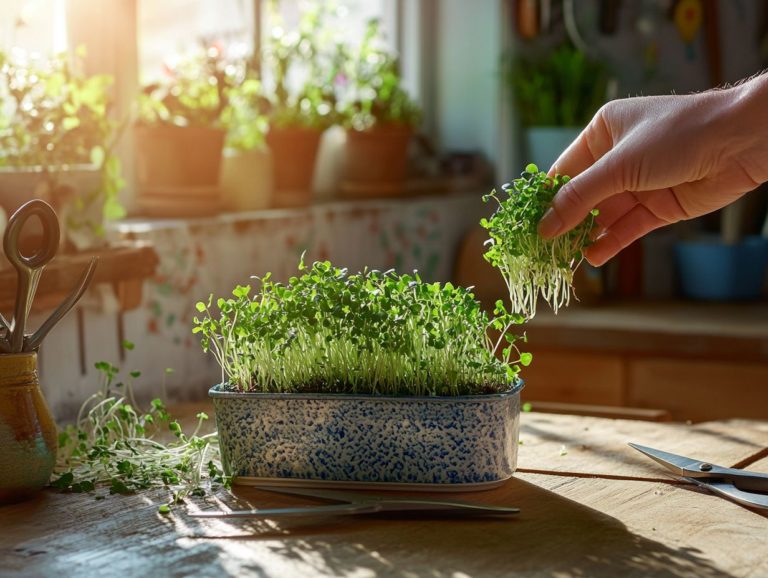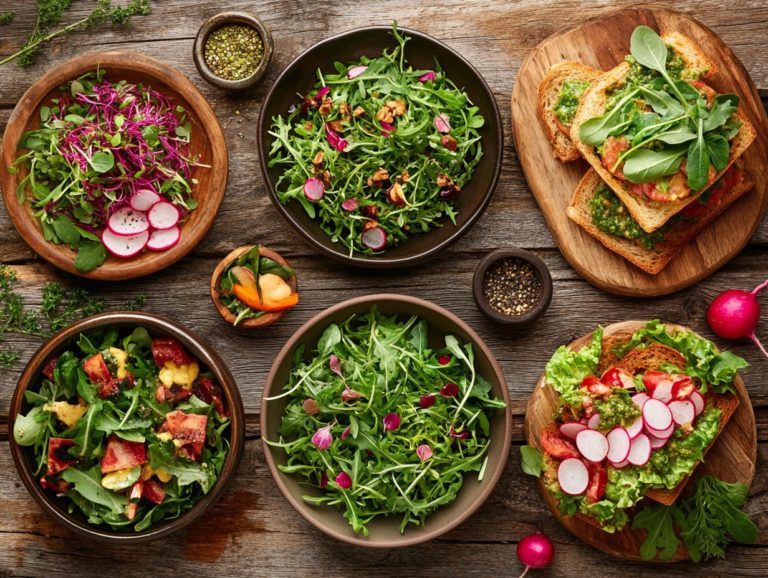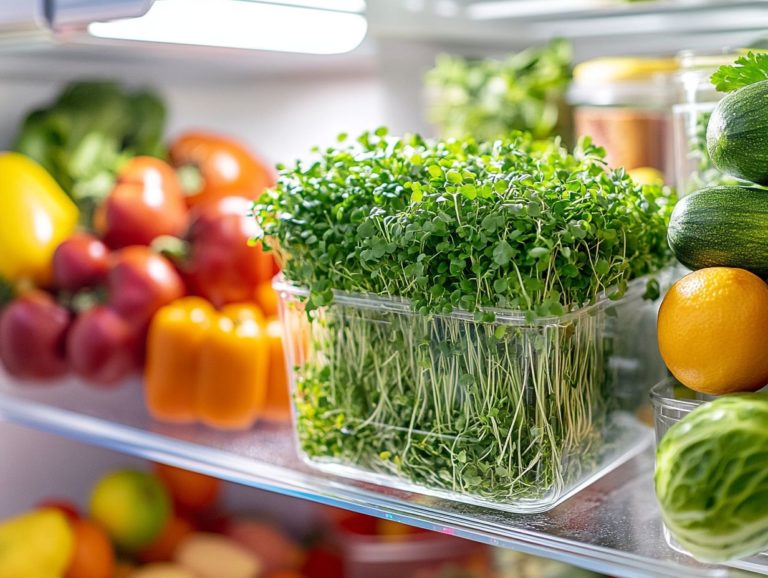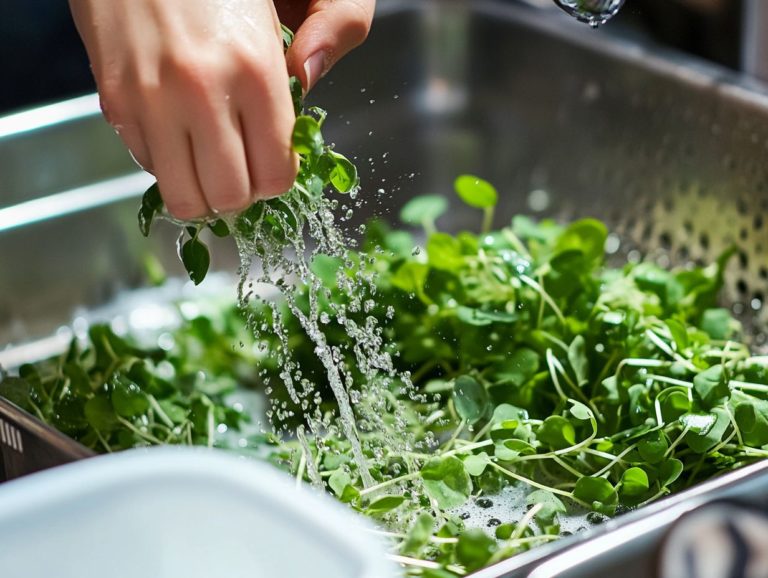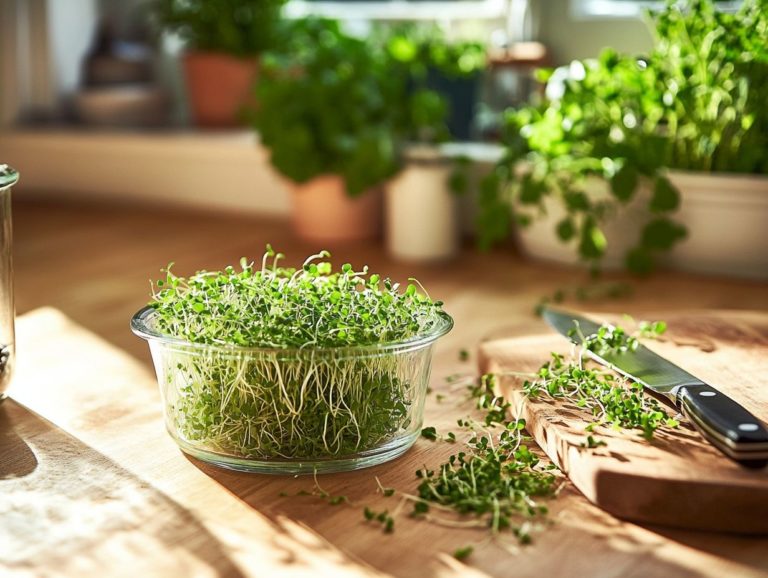The Best Ways to Revive Wilted Microgreens
Microgreens are petite, rich in nutrients plants that effortlessly elevate the flavor and visual appeal of your culinary creations. However, they can easily succumb to wilting due to environmental factors or slight handling errors, such as improper storage techniques that lead to a damp condition.
In this article, you ll discover the definition and nutritional advantages of microgreens, along with the common culprits behind their wilting. You will also learn effective techniques to revive vegetables like microgreens, ensuring they remain a vibrant addition to your kitchen.
You ll also discover practical tips for preventing wilting and innovative ideas for incorporating slightly wilted microgreens into your cooking, including salad recipes that make use of fresh ingredients. Unlock the amazing potential of these tiny greens and elevate your meals!
Contents
Key Takeaways:
Pay attention to these key points to maximize your microgreens experience:

- Maintain proper care and moisture control to prevent wilted microgreens. Keep them in a cool, humid environment and handle them gently to maintain their freshness and nutritional value.
- If your microgreens do become wilted, try soaking them in ice water or giving them a quick blast of cold air to restore their crispness and vitality.
- Use wilted microgreens creatively! Incorporate them into salad greens recipes or as a garnish to add flavor and nutrition to your dishes. They may not look perfect, but they can still pack a punch in terms of taste and nutrients.
What are Microgreens?
Microgreens are the young seedlings of edible vegetables and herbs, typically harvested right after the first true leaves emerge. These nutrient-rich greens, including kale, arugula, carrots, beets, and mustard, deliver a robust flavor that s capturing the attention of home cooks and health aficionados alike.
Their vibrant colors and delicate textures not only elevate the visual appeal of any dish but also provide a concentrated nutrient boost that enhances your healthy eating habits. As a cornerstone of contemporary culinary trends, microgreens can transform salads, sandwiches, and garnishes, offering both aesthetic charm and nutritional benefits.
Definition and Nutritional Value
Microgreens are the young, edible greens you can harvest shortly after germination, and they come with an impressive nutritional profile that includes essential vitamins, minerals, and antioxidants for a balanced diet.
These tiny powerhouses aren t just a feast for the eyes; they re packed with nutrient elements, often boasting higher concentrations of vitamins A, C, E, and K than their fully grown vegetable counterparts. Take kale and radish microgreens, for example they deliver a significant punch of vitamins, making them fantastic allies for your overall health and immune support.
When you incorporate these delicate greens into your meals, you not only elevate flavors but also enhance the nutritional value of your salads, sandwiches, and smoothies. They re a versatile addition to any kitchen. Plus, with their ability to thrive in minimal space, they provide a simple trick for anyone eager to boost their leafy greens intake.
Causes of Wilted Microgreens
Wilted microgreens can often stem from a range of environmental factors and handling missteps that jeopardize their freshness and ability to keep nutrients. Insufficient hydration, improper storage techniques, and exposure to extreme temperatures can rob microgreens of their vitality, leaving them in a damp condition that diminishes their flavor and texture.
As a discerning home cook, it s crucial to recognize these issues, especially when sourcing microgreens from farmers markets or grocery stores, where freshness can fluctuate dramatically and affect the overall vegetable growth.
Environmental Factors and Handling Mistakes
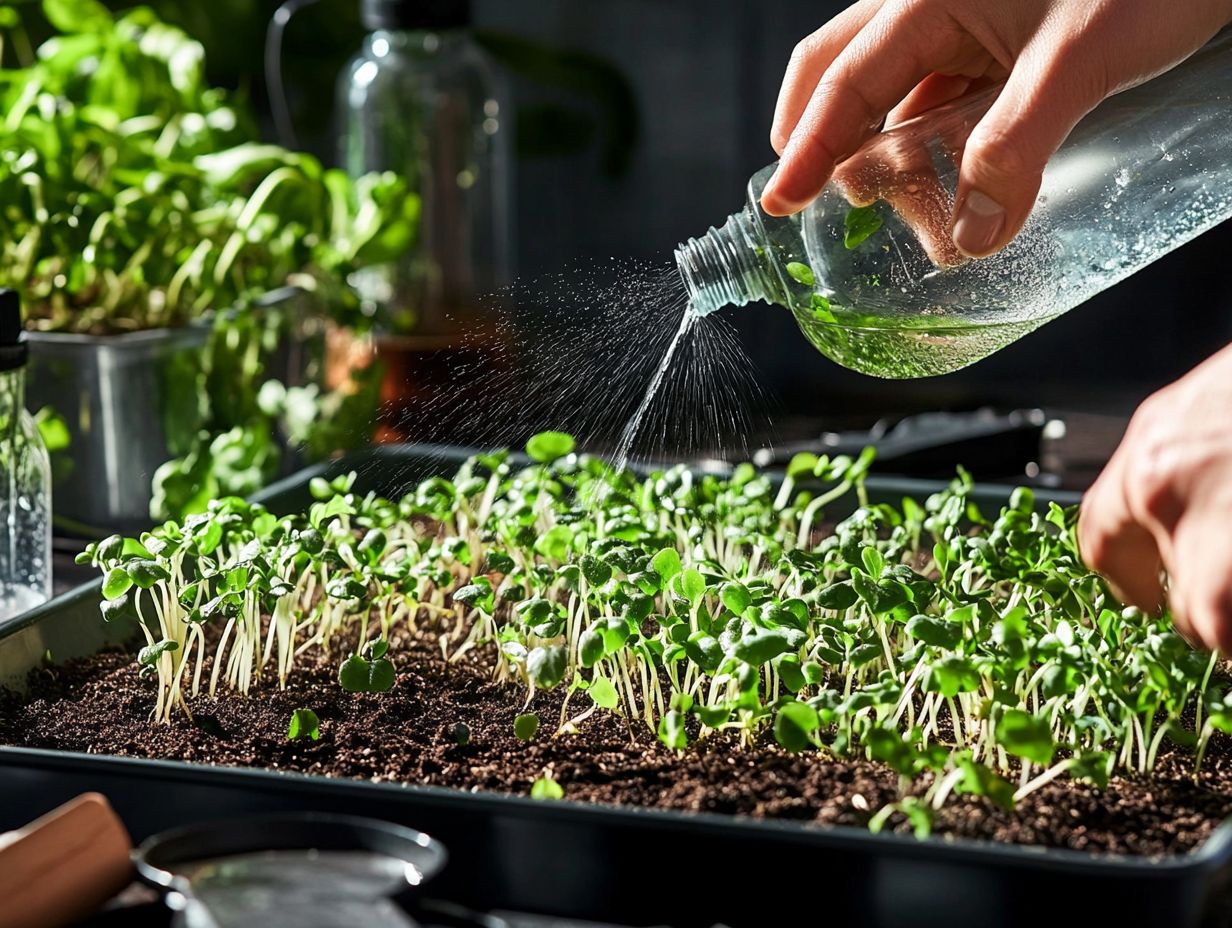
Environmental factors such as temperature fluctuations and humidity, along with handling mistakes like overwatering and excessive light exposure, can lead to the wilting of microgreens, contributing to food waste.
To ensure the health of these delicate greens, monitor their environment closely. Microgreens flourish within a temperature range of 60 F to 70 F and thrive at humidity levels between 40% and 70%. These conditions are similar to those supporting fresh vegetables.
Minimizing direct sunlight exposure during growth is crucial. Instead, use indirect light or fluorescent bulbs to protect them from scorching while promoting healthy vegetable preservation.
After harvesting, preserving the freshness of microgreens requires proper storage techniques. Store them in a sealed container in the crisper drawer of the refrigerator. This retains moisture and prevents spoilage.
Placing a damp paper towel in storage can enhance their longevity. This allows you to enjoy these fresh vegetables for a longer time through effective moisture management.
Reviving Wilted Microgreens
Reviving wilted microgreens is simple yet incredibly effective. This method allows you to restore their fresh appearance and nutrients.
One favored technique is to submerge the wilted greens in a cold water bath for a few minutes. This rehydrates the leaves, transforming them into crispy, vibrant delights.
This method enhances their visual appeal and preserves the essential nutrients vital for healthy eating. Incorporating this clever kitchen hack into your routine can significantly reduce food waste and elevate your culinary game.
Methods for Restoring Freshness
To restore freshness in wilted microgreens, consider using a cold water bath ice water works best for quickly rehydrating those greens. This method revitalizes their appearance and preserves their nutrients.
After rehydration, use a salad spinner to eliminate excess moisture. This step is crucial for maintaining a firm shape and ensures that your microgreens aren’t left sitting in water, which could lead to spoilage and unwanted mold growth. To learn more about what to do with microgreens after harvest, check out this helpful guide.
These methods are effective. The quick cooling from the ice bath locks in nutrients, while the salad spinner enhances air circulation, boosting the greens’ crispness and overall freshness without sacrificing their rich vitamin content.
Preventing Wilted Microgreens
Preventing wilted microgreens is essential for preserving their fresh flavor and nutritional value. You can achieve this through meticulous storage techniques and care.
For example, place your microgreens in the crisper drawer with optimal moisture control to extend their lifespan. Keep them out of direct sunlight to maintain their vibrant color and nutrient content, which is crucial for fresh food preparation.
As a home cook, use absorbent towels to regulate moisture. This creates the perfect environment for these delicate ingredients while preventing excess water absorption.
Tips for Proper Storage and Care
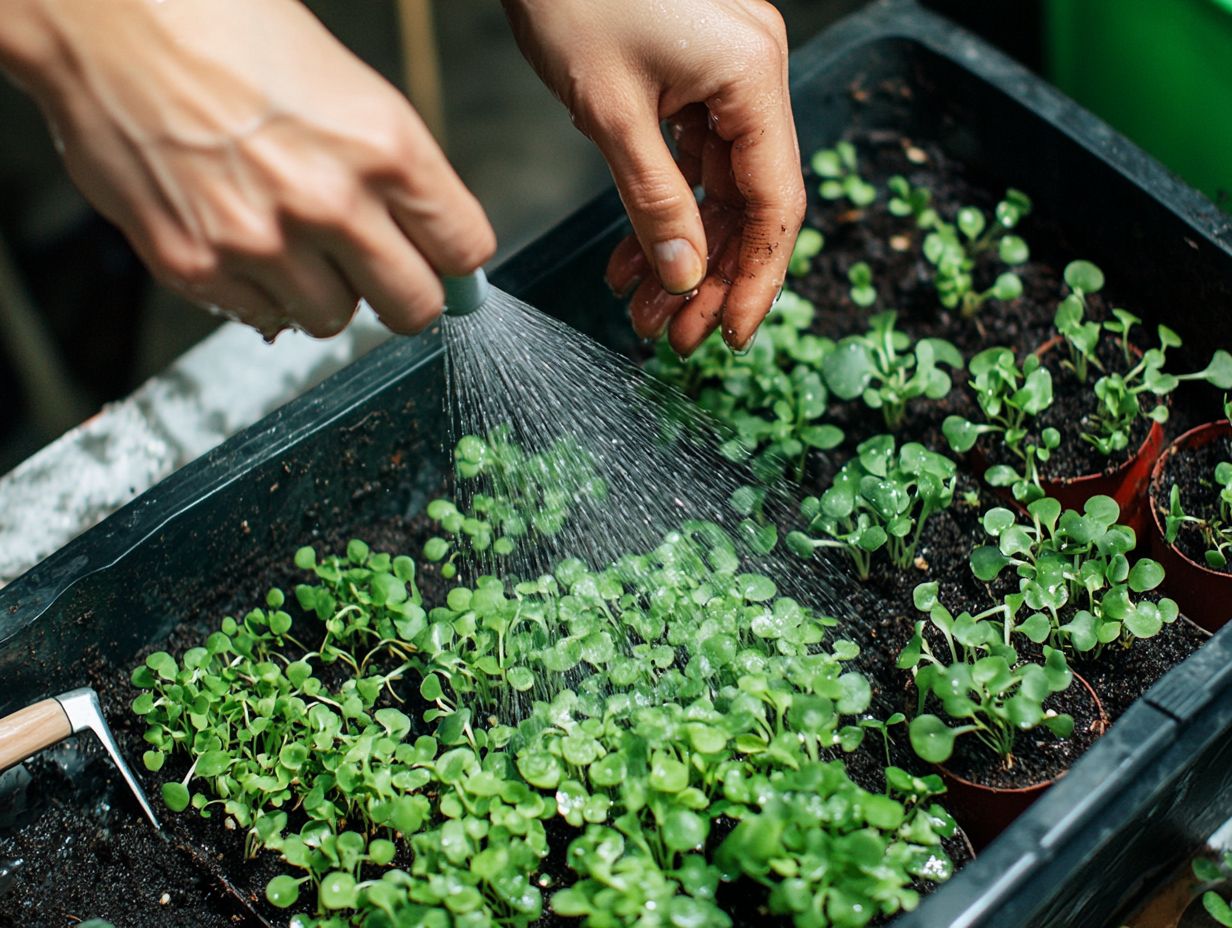
Proper storage and care techniques for microgreens can significantly extend their freshness and flavor. It’s crucial to keep them in a cool, dark place shielded from moisture and extreme temperatures, which is essential for the lifespan of vegetables.
For the best results, consider using breathable containers like mesh bags or clamshells. These options allow for airflow while providing protection for those delicate leaves from potential spoilage. Maintaining ideal temperature and humidity levels is crucial; a refrigerator set between 34 F and 40 F works wonders. Keeping humidity low is essential to prevent mold growth and maintain the health of your fresh vegetables.
One clever kitchen hack to keep your microgreens fresh longer is layering them between slightly damp paper towels. This method absorbs excess moisture without saturating the greens directly, enhancing their overall quality and freshness. For optimal growth, consider using watering techniques for thriving microgreens and check often for signs of wilting to keep your greens vibrant and flavorful.
Creative Uses for Wilted Microgreens
Creative uses for wilted microgreens can transform what might otherwise be seen as waste into tasty meals, highlighting their versatility across a range of recipes and cooking techniques. Even after losing their crisp freshness, these microgreens still pack nutritional benefits and can infuse unique flavors and textures into your meals, making them great for salad recipes.
You can also use wilted microgreens in soups, smoothies, or stir-fries. This not only reduces food waste but also elevates the nutritional profile of your dishes, making healthy cooking (cooking that prioritizes nutritious ingredients) more accessible and enjoyable for you as a home cook. To enhance your knowledge, consider exploring understanding microgreen post-harvest care.
Recipes and Ideas for Using Wilted Microgreens
Incorporating wilted microgreens into your recipes is a brilliant way to reduce food waste while boosting the nutritional value of your meals through wholesome cooking techniques and effective storage techniques. By creatively utilizing these nutrient-dense greens, you can elevate the ordinary to the extraordinary.
Picture this: you stir a handful of wilted microgreens into a warm soup just before serving. It’s a simple trick that preserves their flavor and nutrients. Your salads can also experience a revival with remnants of microgreens, introducing a peppery or earthy flavor that takes your dish to the next level, enhancing the fresh herbs in your mix. For more details on handling these greens, check out these tips for washing and storing microgreens.
And let s not forget about smoothies blending wilted microgreens with fruits and a splash of almond milk not only enhances the texture but ensures that the nutritional content remains intact, especially when using cold water or ice to keep them fresh.
By focusing on minimal cooking time or opting for raw preparations, you can maximize health benefits while indulging in delicious meals that highlight the fresh vegetables in your recipes.
Frequently Asked Questions
What are microgreens and why do they wilt?

Microgreens are young, tender greens that are harvested just after their first true leaves appear. They are packed with nutrients and have a delicate flavor. Microgreens wilt due to lack of water, heat, or exposure to sunlight, much like wilted lettuce.
How do I know if my microgreens are wilted?
Wilted microgreens will appear limp and droopy instead of standing upright. Their color may also look dull or faded. You can also gently touch the leaves; if they feel dry and brittle, they are most likely wilted.
Can wilted microgreens be saved?
Yes, wilted microgreens can be revived with some simple techniques, such as soaking in ice water or using a cold water bath. However, if they have been wilted for too long, they may not be salvageable.
What is the best way to revive wilted microgreens?
The best way to revive wilted microgreens is to give them a good soak in cold water. Submerge the entire tray or container in water for 10-15 minutes. Then gently shake off any excess water and allow them to drain. You can use absorbent kitchen towels to speed up the drying process.
Can wilted microgreens be used for cooking or juicing?
Yes, wilted microgreens can still be used for cooking or juicing. They can be incorporated with other fresh vegetables like carrots, beets, and leafy greens. However, their texture and flavor may be slightly affected. Revive them using the cold water bath technique before adding them to your favorite salad recipes.
How can I prevent my microgreens from wilting in the first place?
Keep your microgreens thriving and fresh! Water them regularly and keep them in a cool, shaded area. Check the moisture level of the soil daily, which means keeping the soil damp but not soggy. Avoid exposing them to direct sunlight for extended periods.
This will help ensure nutrient retention and the overall health of your plants. Don t let your microgreens wilt try these simple tips today!


